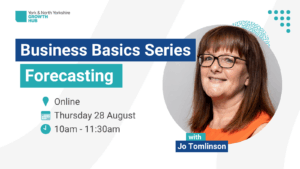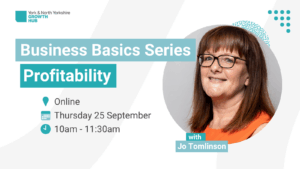Navigating the Latest Budget: A Survival Guide for Small to Medium Businesses
The Budget announced on October 30th will bring substantial changes for many organisations, resulting in increased costs. So, how can we navigate these changes and still maintain profitable businesses?

Your Payroll Numbers
In the Budget, changes were announced to the Minimum National Wage and also employers’ National Insurance. You need to understand how these changes will directly impact your business before proceeding with anything else.
Review your payroll figures for the current financial year and use that to predict the numbers from April 2025:
If you already have an up-to-date forecast of your business’s numbers, this information should be included in it, but may need updating. If not, you’ll need to create a forecast for the period from April 2025 onwards. Use your payroll software to generate a list of employees:
- Name
- Age
- Basic pay
- Hours worked
- Deductions including employers’ National Insurance contributions
- Pension contributions etc
Identify Employees affected by Minimum Wage changes:
From your employees list, determine who will be impacted by the new Minimum Wage legislation.
Consider if any employees currently earning slightly above the Minimum Wage (e.g. 20p/hour more) will expect to maintain this differential. You may need to rework your numbers to include these potential increases too.
Re-calculate your payroll numbers using the new basic rates (due to the increased National Minimum Wage) and the employers National Insurance impact on these numbers. Ensure you include:
- The increased rate from 13.8% to 15%
- The lower threshold above which employers’ national insurance is charged from £9,100 p.a. to £5,000 p.a.
Apply the Employment Allowance:
Deduct the Employment Allowance from your newly calculated payroll numbers.
Note: In some cases, the increase in Employment Allowance may exceed the entire employers’ National Insurance liability for the year.
Calculate the Net Impact:
Subtract the Employment Allowance from the newly calculated payroll costs to assess the overall impact of the Budget changes on your payroll costs for the next year.
If you are unsure how to perform these calculations, I have provided explanations on how National Insurance is calculated manually, along with examples, in Appendix 1.
Your Non-Payroll Numbers
The impacts of the Budget are likely to be seen across most of the things you buy for your business. The payroll changes we calculated earlier will also impact nearly every other business, so we need to consider how our other costs might increase in the coming year.
What does our Margin look like?
Now that we have recalculated all our costs for the next financial year, we should update these figures into our Budget or Forecast for the year. This will give us an initial view of how the Budget affects our margin.
So, now that we know our numbers, what are our choices?
We can increase our Prices.
Raising prices to maintain your margin is definitely an option to consider.
Using the impact of the Budget on your cost base as a justification is something many businesses will be doing, and you could too. Calculate the increase in your total cost base as a percentage, then simply add that percentage to your prices. Inform your clients about the change and see how they respond.
Alternatively, you could take this opportunity to conduct a pricing review.
How to undertake a pricing review:
- Routine price increases: When was the last time I raised my prices? It’s my recommendation that you implement at least an annual increase to keep in line with any cost-of-living increases you are incurring. Include a note that you will do this in any proposals you raise.
- Analyse your products and services: Review each product or service (or groups of similar offerings) separately. This ensures that high-margin sales are not masking low or negative-margin products and services.
- Break down direct costs: Calculate the direct costs associated with your products and services to determine the gross margin for each.
- Allocate non-direct costs (if feasible): If you can allocate non-direct costs that’s great. However, this can often be arbitrary, and the effort to calculate it may outweigh the value derived from it.
- Conduct market research: Investigate what your competitors are charging for similar products or services? It’s important to understand how your offerings differ from others in the market and how to articulate these differences effectively.
- Attend the Pricing Workshop: Learn valuable strategies around pricing and how to use them to maximise your profit.
We can review our costs
Ensure we can maintain the quality of our supply so that our customers do not notice any changes we make:
- Lesser quality ingredients could lose us customers. We also need to consider potential supply issues.
i. Do we need to buy in larger volumes less frequently to drive the cost down?
ii. Is the new supplier reliable?
- Lower cost suppliers, may not provide the full scope of services we need or may not deliver the level of service we are used to:
i. Additional work may fall back on you, creating hidden added costs.
- Can we reduce the size of our offerings to meet the price point without compromising the perceived value? Those wagon wheel biscuits were definitely bigger when I was a kid!
- Can we bulk buy? Consider the implications for cash flow, storage and shelf life.
- Are there any costs we could cut that the customer wouldn’t notice?
Consider make vs. buy options
This may involve investment in training or equipment and could require lead time. But this option cuts out someone else’s margin!
Consider outsourcing tasks you currently handle in house
- This could include hiring a VA (Virtual Assistant) or Bookkeeper instead of employing an in-house administrator
- IT support
- Credit control and debt collection
- Hiring temporary staff during busy periods rather than maintaining full-year staffing, especially if your business is seasonal
Rent/Lease Considerations
- Do you need to be in your current location? Could you work from home?
- Can you sub-let unused space? (Check your lease terms.)
- Could you move to a lower-cost location or smaller premises?
Review current team.
-
- Are any employees receiving benefits they don’t need (e.g. mobile phones?)
Entertaining/Gifting
-
- Evaluate whether these activities or gifts actually provide value to your business.
We can explore new Opportunities or maximise current ones
-
- Are there ways you can increase your revenues?
-
- Can you explore new routes to market?
-
- Can you tap into new markets?
-
- Can you offer new products or services?
-
- Are there ways to increase the frequency of repeat purchases?
-
- Promotions
-
- Referrals – introduce a “refer a friend” scheme.
-
- Loyalty schemes.
-
- Are there ways to increase the average sale value, other than raising prices?
-
- Can you leverage reviews to build trust and encourage more sales?
Planning for Business Success
Once you have thoroughly reviewed the changes you can make to maintain your margins, you need to quantify the impact of each strategy.
The changes you make need to be carefully planned, and their results need to be measured.
For each aspect of your business that you are considering changing, ask yourself:
-
- What is the lead time for trialling the proposed new or changed activity?
-
- What impact on sales or costs will there be, and from when?
-
- Are there any risks associated with the change?
-
- Will you trial the change first before rolling it out on a larger scale?
-
- What will the overall impact on cash flow be?
-
- Will you need to explore access to additional finance?
Click here to download this resource and access the Appendix

Sign up to our FREE webinar; Navigating the Latest Budget: A survival Guide for Small Businesses happening on Tuesday 7 January, 10am-11:30am
Business Basics - Forecasting
Although we don’t have a crystal ball, so forecasts are fundamentally informed guesses, businesses need to use them to make informed business decisions and develop business strategies.
Profitability
Profit is a measure of a business’s income relative to its expenses. In other words, an organisation’s ability to generate revenue by using resources that it has available, such as people, materials and equipment. Unless you are running a charitable organisation, profit is generally the primary goal of a company. As well as providing income for the owners of a business, profits allow for investment and growth. Whilst revenue growth is generally a positive indicator, we need to understand profitability if a business is to be successful.
Business Essentials: What is a Tax Deductible Expense?
As a business owner, it can be daunting when you are trying to work out what you can and can’t claim as tax deductible expense. Other business owners will give you their opinion but is that the right advice for you and your business? You can search online, but this can be confusing and often contradictory. So, what can you claim?
Financial Management – Do you know your numbers?
One of the most important things a business owner should know, is “their numbers”. Do you know how well your business is performing and in which areas? Do you know who you owe and who owes you? Can you afford to make upcoming payments and meet your financial obligations?
Bookkeeping for Business Owners
Business owners often handle their own bookkeeping when they first start out, as they are time-rich but money poor. However, bookkeeping isn’t a skill you acquire simply by registering a business. But with a robust process, great software, a little training, and someone to call when you’re unsure, it is possible to do this well, even as a novice.
Pricing for Maximum Profit
Are you charging enough for your products or services to allow you to provide a service you are proud of and that allows you to not become a busy fool? Are you confident that you are charging the correct price for your goods or services?
Navigating the Latest Budget: A Survival Guide for Small to Medium Businesses
The Budget announced on October 30th will bring substantial changes for many organisations, resulting in increased costs. So, how can we navigate these changes and still maintain profitable businesses?
The importance of having a robust debt collection strategy for your business
Efficient debt collection is a key driver for growth in a business and a fundamental part of operating with healthy cash flows. It’s because, without the cash available when it’s needed to run the business day-to-day, there’s a risk of falling into financial decline.
What are the finance options for a struggling company?
Running a struggling company in financial difficulty is certainly challenging. However, with so many different finance options now available that don’t involve the high street banks, be reassured that you can quickly secure the cash injection you need and get back on track.
How to write a good business plan
Organisations such as the Start-Up Loan Company...
Peer to peer lending Q&A
Looking for an alternative route to financing your business? Peer to peer (P2P) lending is one of the options.
How digital tax will benefit your business
You will probably have heard about digital tax but what does it actually mean for you and how will it benefit your business?












